Single-key models of pass-through switches allow you to control one lighting system from several places. Duplicating devices differ from standard ones in a large number of contacts. The correct connection diagram of the pass-through switch will allow you to create communications with independent control.
- Design and differences of rocker switches
- Selection options
- Where is a similar lighting control system used?
- Connecting the intermediate switch
- Connection diagram for PV cables in a junction box
- Features of connecting a one-rocker switch from two points
- Connection requirements
- Connection algorithm
- Characteristics of touch models of switches
- Basic connection errors
- Cons of a pass-through switch
Design and differences of rocker switches
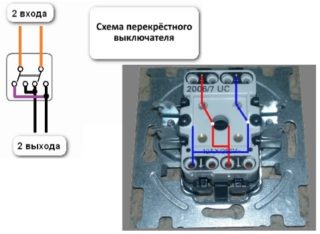
A pass-through switch is used to turn on and off light from different ends of a room or hallway. The activation of light sources is usually carried out near the entrance to the room, and deactivation - from another area.
Duplicate models may look like standard switches on the outside. The front movable side is marked with arrows pointing up and down. If a standard switch has one input and one output, then a rocker switch has two. Such a constructive technique excludes a break in the current - it is redirected to the output.
Changeover products have 3 copper contact terminals. You can see the connection diagram under the case. A simple switch has two-wire switching, and a pass-through switch has a three-wire one, to redirect the voltage from contact to contact.
It is necessary to connect paired devices for one light source, with a supply to each phase and zero. By changing the position of the button, the user closes the circuit - the lamp will light up. The opening of the phase cable occurs when it is turned off - the light goes out.
Keys in one position - light is on. In different positions - off.
Selection options
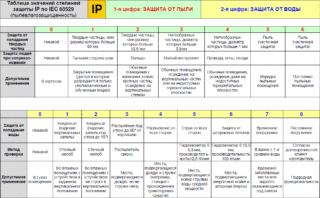
Before purchasing a switching device, you must take into account:
- control type - key, sensor or remote control;
- installation method - installation is carried out by the overhead (open wiring, on self-tapping dowels) and built-in (hidden wiring, in socket outlets on spacers) method;
- compatibility with light sources - models X and AX are suitable for fluorescent lamps, A for incandescent bulbs;
- degree of protection - in bedrooms it is allowed to install switches with IP03, in bathrooms - with IP04-IP05, outdoors - with at least IP55;
- contact clamps - the intermediate device is equipped with screw clamps with pressure plates or screwless fasteners.
The switching products are connected to a three-core wire with a cross section of 1.5 mm2.
Where is a similar lighting control system used?
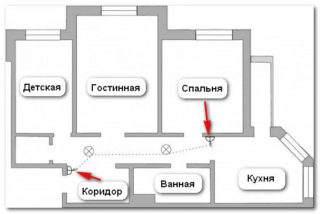
The walk-through switch increases comfort and the ability to control one luminaire or a group of lamps from several locations. The technology is used in apartments, public buildings and private houses:
- Stairways. The marching lamp turns on at the bottom, and turns off at the top by a person after climbing the stairs. The circuit allows you to install a time relay so that the light is turned off autonomously.
- Long corridors. A convenient option for residents of private houses. If it is necessary to leave the room, the switch is used at the beginning to light up the light.After crossing the corridor, it is enough to turn off the light by pressing the button of another device.
- Walk-through rooms. The lamp is turned on near the doorway. Entering another room, the user does not come back - the line is de-energized immediately.
- Bedrooms. The light comes on at the door and off next to the bed.
The wiring diagram is relevant for underground passages, in entrances.
Connecting the intermediate switch
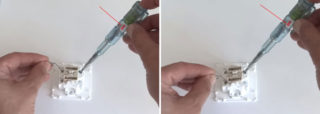
Before connecting the switch, you need to find the circuit on the back. Next you will need:
- Remove the button and the patch frame from the product.
- After disassembly, find 3 contact terminals and select a common one according to the diagram on the case.
- In the absence of designations or misunderstanding, you can use a tester or a screwdriver with an indicator.
- With the multimeter probes, touch all the contacts and find the one that, when touched, the device will beep, give a zero value when the keys are turned on or off.
- Perform a similar test with an indicator screwdriver.
- Connect a phase from the power cable to the common terminal.
- Throw the remaining terminals to the two remaining conductors.
The duplicating device is connected in the same way.
Connection diagram for PV cables in a junction box
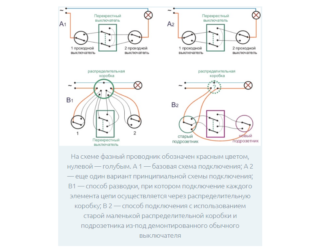
An important step is the assembly of the circuit breaker circuit in the switch box. 4 wires with 3 cores go into it - the power cable from the light control machine from the switchboard, the cable to the 1st and 2nd switches, the cable to the light source.
In the process of work, you need to focus on the color of the wire:
- phase - white / gray;
- zero - blue / brown;
- ground - yellow-green / black.
The assembly involves the following step-by-step algorithm:
- Connection of the neutral core coming from the input cable of the machine and zero, which goes to the luminaire with terminals.
- Connection of all earth conductors with a grounding conductor. The ground from the input is thrown to the ground of the outlet with terminals.
- Ground connection to the luminaire body.
- Coupling the phase from the input cable with the phase from the outgoing cable and fixing them to the common terminal in the 1st switch.
- Coupling the common wire of the 2nd switch with the phase of the lighting cable with a terminal.
- Connection of secondary outgoing conductors of switches No. 1 and No. 2.
- Applying voltage and design testing.
Stick to the color coding to avoid confusion later.
Features of connecting a one-rocker switch from two points
The circuit of the switch, controlled from two places, provides for the use of paired devices, the plant of the lamp wires and three-core switch cables in the switch box. For work, you will need screwdrivers (indicator, flat, cross), a stationery knife, side cutters, a puncher, a level and a tape measure.
Connection requirements

The correct installation process involves:
- functioning of switches in a pair - they must duplicate each other;
- chipping the wall with hidden installation or the use of trays / boxes with open wiring;
- planting the ends of cables in junction boxes and connecting by contactors;
- the use of 5 cables - 1 for power supply from the machine, 3 for switches and 1 for lighting;
- use of a three-core copper wire with a cross section of 2.5 mm2;
- output of zero and ground to the lamp directly;
- routing the brown phase wire through the switches to the lighting fixture;
- tossing switches in a phase cable break.
The phase through the switch is needed for the safety of repair or replacement of fixtures.
Connection algorithm
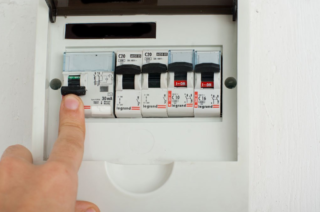
The connection diagram of the 2-point pass-through switch is implemented as follows:
- De-energizing the room through the flap.
- Checking the presence of voltage with an indicator screwdriver.
- Removing the insulation from the ends of the wires.
- Finding the phase cable with an indicator screwdriver.
- Fixing the phase wire with one of the wires (white or red) of the switch by twisting.
- Connection of wires to each other with zero terminals.
- Throwing a separate wire from the switch No. 2 to the lamp.
- Twisting the cable from the luminaire to zero in the junction box.
The twist is soldered and wrapped with electrical tape.
Characteristics of touch models of switches
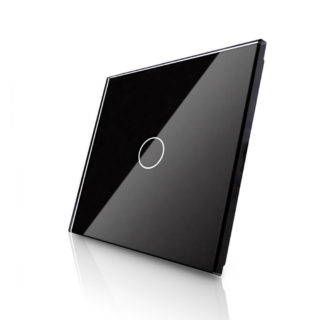
A touch-sensitive switch for light sources switches the current by means of a high-power transistor or thyristor. The signal to open or close the gadget is supplied from a sensor that reacts to an external stimulus.
Two types of sensors are used as a sensor - acoustic or motion. There are models with capacitive sensors that respond to touches from 1-3 cm. The devices are controlled remotely, which increases their functionality.
Externally, the touch-sensitive one-button switch looks like a smooth glass panel. Light indication is visible at the moment of connection. Red indicates enable, blue indicates disable. The devices can be connected to incandescent or gas-discharge lamps. The group of the touch switch and the LED lamp is malfunctioning, but the problem is eliminated by means of a special adapter.
Basic connection errors
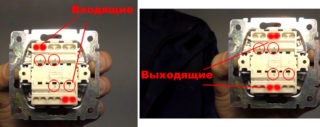
In the process of assembling a synchronous structure, novice craftsmen make several mistakes:
- Using more than 2 transfer switches. Costs for cable and junction boxes are increasing.
- Wrong choice of common terminal. An item with one contact can be anywhere. To find it, you need to make a continuity with a multimeter or an indicator screwdriver.
- Twisted wires. The problem arises when installing devices from different manufacturers.
- Incorrect connection of crossover models. Two cables of device no. 1 are placed on the upper contacts, and device no. 2 - on the lower ones. It is necessary to make an exclusion and put them crosswise.
The cross-type switch cannot be identified from the backlight.
Cons of a pass-through switch
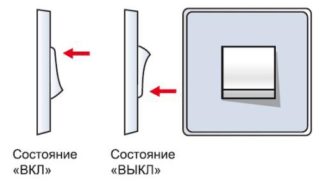
Despite the quality of light control and an increase in the comfort of living in an apartment or house, duplicate switches have disadvantages:
- There is no marking of off and on keys, as in standard models. For this reason, it is impossible to determine when the lamp has burned out. To replace it, the light machine is de-energized through the shield.
- A large number of twists in the junction box. The number of connections depends on the number of light points. You can reduce twists by connecting the cable directly, but this will increase the footage. For ceiling lights, you will need to run the wire up, lower it down, connect it to the switch and bring it up again. The problem will be solved by an impulse relay through which the cable will pass.
- Lamps from different points do not turn on or off at the same time.
Insignificant disadvantages practically do not affect the quality of the devices. If the switch circuit is implemented by hand, at first the user may be confused.
The convenience of pass-through switches saves time returning from one end of the room to the other to turn off the light. All models look neat, stylish, and with proper connection they will last for several years.








